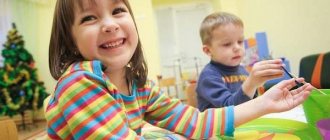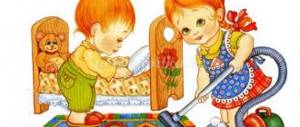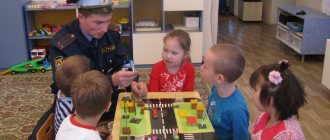Consultation for parents: Hardening of preschool children
Consultation for parents of preschool educational institution “Hardening of preschoolers.”
Dear colleagues, everyone knows sometimes how difficult it is to arouse interest among the parents of our students in the activities of preschool educational institutions.
To do this, we carefully update the information in the parent corners. I invite you to get acquainted with one of my works on consulting parents on the topic “Hardening preschool children .
Hardening preschool children If you want to see your child physically strong and healthy, harden him. To do this, you can widely use natural factors - air, sun, water. Accustom your child to fresh air, cold water from an early age, and develop his ability to overcome difficulties. It must be remembered that you will receive a positive effect from hardening only if it is carried out systematically, without interruptions, in compliance with all the doctor’s requirements and taking into account the individual characteristics of your child. You need to know that a long break in hardening (more than 2-3 weeks) again increases the body’s sensitivity to cooling. Therefore, after a child’s illness, hardening procedures must be continued at higher temperatures than those achieved before the illness. To get a positive effect, you must: 1. Take into account the age, state of health, individual characteristics of the child, and his mood. 2. Gradually carry out hardening procedures, changing their types, depending on the season and weather. 3.Gradually increase the strength of the influence of the natural factor. There are 3 main ways of hardening children: 1. Air hardening. 2. Hardening with water. 3. Sun hardening. And of course, you shouldn’t forget about morning exercises and exercises after sleep. Morning exercises and exercises after sleep are carried out in the warm season with one-sided ventilation. in cold weather (winter) - with the windows closed, but immediately after the room has been ventilated; in summer - outdoors. If children are already accustomed to cool air, then for the entire time they are awake they are left in lightweight clothing (socks, short sleeves) not only in summer, but also in winter. Hardening children with air The first requirement for hardening is the creation of normal hygienic living conditions for the child. To keep the air in the room clean, it is necessary to carry out wet cleaning daily and constantly ventilate the room, the air temperature in which should be about 22 degrees. Gradually teach children to be indoors, first with one-way ventilation, and then with corner ventilation. Through ventilation is carried out in the absence of the child, allowing the temperature to drop to 15-17 degrees and stopping it 20-30 minutes before the child returns (the time required to restore normal temperature). Daytime sleep in the open air is very useful: on the veranda or in the garden, in a well-ventilated area, regardless of the time of year. In the middle climatic zone, daytime sleep in the open air is carried out even in frost, but in the absence of wind. Thanks to walks and properly organized daytime sleep, even in winter, the child is in the fresh air for 4-5 hours. In summer, in warm weather, a child should be taught to walk barefoot. Children receive air baths when changing linen after night and daytime sleep, while dressing and undressing independently. During these 6-8 minutes the child is completely or partially naked. In addition, he receives air baths while wearing lightweight clothes (pants, a T-shirt, slippers) during daily morning exercises, which are introduced into the daily routine of children from the beginning of the third year of life. If children are already accustomed to cool air, then for the entire time they are awake they are left in lightweight clothing (socks, short sleeves) not only in summer, but also in winter. Hardening children with water Begin with extremely weak effects on a limited part of the skin (local wiping, dousing), then move on to general wiping of the entire body. For local exposure, they start with water at 30 degrees, every 1-2 days it is reduced by 1-2 degrees until it reaches 18-16 degrees. For the general effect, the initial water temperature is 35-34 degrees, every 3-4 days it is reduced by 1-2 degrees and brought to 24-22 degrees. Washing.
When washing children over two years old, they wash their face, neck, upper chest and arms to the elbow.
In summer, you can wash your children with cool tap water. Rubbing. The effect of rubbing is much stronger than washing. Wiping is carried out with a mitten made of soft fabric or the end of a towel moistened with water at the desired temperature. The limbs are wiped, lightly massaging the skin in the direction from the fingers to the shoulder. General rubbing is carried out in the following sequence: first wipe the upper limbs, then the chest, stomach and back. Pouring. You need to start with a local douche. The legs are poured from a ladle (capacity 0.5 l), water is poured onto the lower third of the legs and feet. Be sure to follow the rule: pour cool water only on warm feet. The actual dousing lasts 20-30 seconds, followed by rubbing. General dousing has a stronger effect. It is better to douse the child from a jug with a capacity of 1.5-2 liters so as to immediately pour over the entire surface of the body. Playing with water can also be used as a hardening procedure. It is important to maintain the appropriate water temperature (28 degrees). While watching the children, you can gradually reduce the water temperature to room temperature, without, however, allowing the phenomenon of cooling. In the warm season, after preliminary hardening with air, playing with water and dousing can be done in the open air, while protecting the child from the wind. Hardening children with the sun Hardening with the sun is carried out during a walk during the normal activities of children. Sometimes sun hardening is approached incorrectly, requiring children to lie still. Children should not be placed on mats for sunbathing and turned after a certain time: it is difficult for healthy children to lie still. Children must wear a light-colored hat. The walk begins with light-air baths in the shade of trees. Children must wear a light-colored hat. The walk begins with light-air baths in the shade of trees. Then, for 5-10 minutes, the children’s play is moved into the direct rays of the sun and again into the shade. This is repeated 2-3 times during the walk. It is necessary to prevent the onset of overheating, therefore, when a slight reddening of the child’s face appears, they take the child into the shade, engage in quiet play, and give him a few sips of water to drink. As tanning develops, sunbathing becomes longer. We wish you not to get sick and attend kindergarten!
We recommend watching:
Creativity of preschoolers. Advice for parents Advice for parents. Child's readiness for school Recommendations for parents from a speech therapist Consultation for parents. Play in a child's life
Similar articles:
Consultation for parents “Modern children. Problems of education"
Signs of weak immunity
The baby’s health does not immediately become vulnerable. How to understand that a child’s immunity needs support? Indirect and direct signs include:
- A pediatrician makes a diagnosis of ARVI 4 to 6 times a year.
- Even minor hypothermia can cause a cough or runny nose.
- The child is characterized by constant lethargy and drowsiness, and a reluctance to participate in outdoor games.
- Headaches, allergies, skin rashes.
- It takes a long time for a child to recover from an illness.
- High susceptibility to colds and other diseases.
- Atypical course of the disease.
This is interesting ! Elements of hardening were used by Hippocrates; complexes to strengthen the immune system are included in the systems of yoga and many martial arts.
How often does your child get colds during the year?
- From 1 to 3 times a year 50%, 7 votes
7 votes 50%7 votes - 50% of all votes
- More than 5 times a year 43%, 6 votes
6 votes 43%
6 votes - 43% of all votes
- From 3 to 5 times a year 7%, 1 vote
1 vote 7%
1 vote - 7% of all votes
- Never 0%, 0 votes
0 votes
0 votes - 0% of all votes
Total votes: 14
31.05.2018
×
You or from your IP have already voted.
Where to start hardening a child
You need to start hardening by changing the lifestyle of the whole family. After all, the strengthening of the protective functions of the immune system will not occur when dousing with cold water. To effectively strengthen a child’s health, hardening procedures should include other simple activities.
To do this, it is enough to bring the baby’s lifestyle closer to the natural.
- Regular walks
The child should be outside every day and play actively in the fresh air. This significantly strengthens the baby's immunity. When choosing between a walk and watching TV, parents should give preference to spending time together outside.
- Don't mess around!
Pay attention to how many layers of clothing your child is wearing. Dr. Komarovsky says that at temperatures above 23 degrees, one thin layer of clothing, a dress or a sleeveless T-shirt is sufficient.
The child is constantly on the move and freezes much less often than the parents. Dressed warmly, in several layers, babies quickly sweat, which causes the development of diseases.
Doctors recommend gradually accustoming the baby to light clothing and allowing him to run around the house barefoot. This stimulates the reflex zones that are located on the foot and perfectly strengthens the child’s immunity.
- Weather in the house
One of the causes of frequent colds is considered to be too dry indoor air.
Overdried mucous membranes lose their protective properties and cease to resist viruses and bacteria. This is especially true for rooms with additional heaters and heated floors. In houses where heated floors are constantly running, air humidity drops to 20%, with normal levels being 40-60%.
If the air in your apartment is too dry, you should think about methods of additional humidification.
The temperature in the room should be 20-22 degrees. Maintaining sufficient humidity and temperature conditions in the house will protect the baby from many problems.
- Daily regime
The correct balance of exercise, walks in the fresh air and rest forms the basis of the baby’s health. It is important to prevent the baby from being overloaded with too many sections and increased psycho-emotional stress.
- Proper nutrition
A healthy diet consists of sufficient intake of nutrients from food that are involved in the formation of the body’s defense against infections. It is undesirable to eat heavy food, overeat and force-feed the child. You need to follow a feeding schedule and eat simple and healthy food.
- Hardening procedures
The rational use of hardening procedures has a positive effect on the baby’s body, improving blood circulation, metabolism, and the functioning of the nervous system. The child gradually adapts to the effects of hardening factors, and the ability to resist infections increases.
Hardening procedures are divided depending on the environmental factor that affects the body. The most common and effective systems for hardening children are water and air procedures, and sun hardening.
Strengthening your child's health
Often, increasing disease resistance does not require special financial costs or burdens. You can effectively strengthen the body’s defenses by revising many habits and changing the lifestyle of the family as a whole, for example:
- Change or diversify your diet . There is a saying that immunity is hidden in the intestines. Its microflora is maintained at the proper level by eating certain foods: fermented milk products containing prebiotics, berries, fresh fruits, vegetables, especially the cruciferous family: cabbage, radishes, turnips.
- Increase physical activity , especially in nature.
Among other things, swimming is especially beneficial. - Review the period of wakefulness and sleep : go to bed and get up in accordance with the natural biorhythms of a person.
- Provide vitamin therapy , especially during periods of transition and at the peak of epidemics. You can enrich the menu with useful substances by adding herbal teas, honey and beekeeping products, citrus fruits, and dried fruits. It is advisable that they be on the family table every day.
- Temper the child . For those who doubt the effectiveness of the method or simply don’t know where to start or how to harden a child correctly, you can familiarize yourself with various methods and scientific data confirming the beneficial results of the procedures.
But Dr. Komarovsky believes that children do not need to be hardened . Take a look and see for yourself.
Benefits of hardening
The increase in immunobiological resistance during cold procedures was proven in the last century by academician Ilya Arshavsky. He is the author of numerous publications on pediatric physiology. The Nikitin couple, who subsequently developed their own education system, established a relationship between hardening and reducing the manifestations of allergies. The following effects from hardening activities include:
- Stabilization of the nervous and endocrine systems. The consequences of stress, overwork, and increased psycho-emotional stress are reduced.
- Improving the functioning of the circulatory system increases tone, improves the condition of the skin, and protects against varicose veins.
- Increased immunity to colds due to changes in external factors: lower temperatures, stronger winds and others.
- The course of the disease in hardened children is much easier and shorter in duration. Less chance of complications.






